Abstract
1. Nine non-steroidal anti-inflammatory drugs were tested for antagonism of bradykinin-induced bronchoconstriction in guinea-pig lungs in vivo. Only one, benzydamine, was inactive.
2. The descending order of potency of the active anti-inflammatory drugs was meclofenamate = Scha 306>Scha 87/2>indoxole>Mi85>indomethacin>glafenine>ibufenac.
3. Of eight other drugs tested, chlorpromazine, phenoxybenzamine and four others were inactive, whereas phenelzine and mebanazine possessed activity.
4. In tests at two dose-levels of meclofenamate, the dose-ratio of bradykinin increased proportionately with the dose of meclofenamate.
5. The anti-bradykinin effect of meclofenamate was still observed after destruction of the brain and spinal cord, after bilateral adrenalectomy or after blockade of β-receptors for adrenaline.
6. Meclofenamate did not release catecholamines from the adrenal medulla or prevent such a release by bradykinin given intra-arterially.
7. The fenamates and like-acting drugs reduced the intensity of anaphylactic bronchoconstriction in guinea-pigs treated with mepyramine or propranolol. The descending order of potency was meclofenamate>flufenamate>mefenamate.
8. Dose / response curves for the antagonism of anaphylactic bronchoconstriction by the fenamates, in the presence of propranolol, turned downwards at high doses.
9. These findings suggest that the fenamates may find a useful place in the treatment of bronchial asthma or other conditions involving allergic ventilatory impairment.
Full text
PDF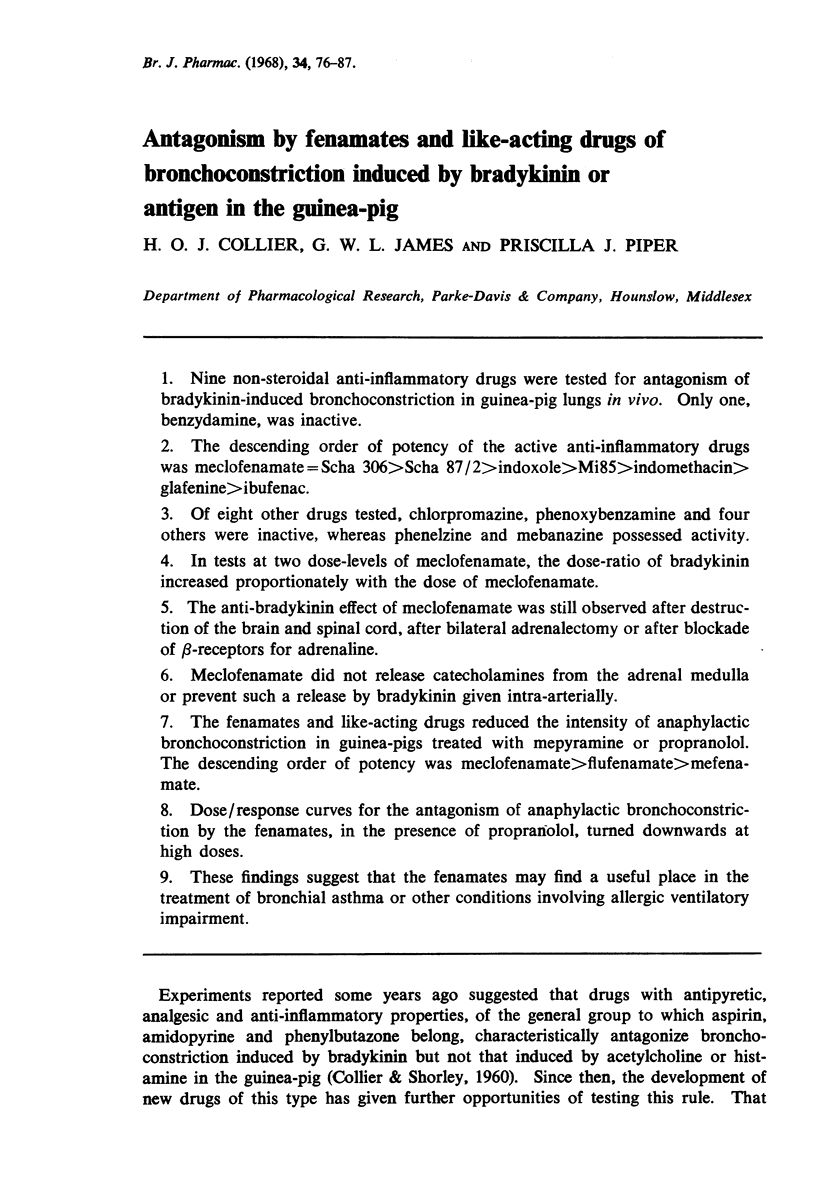
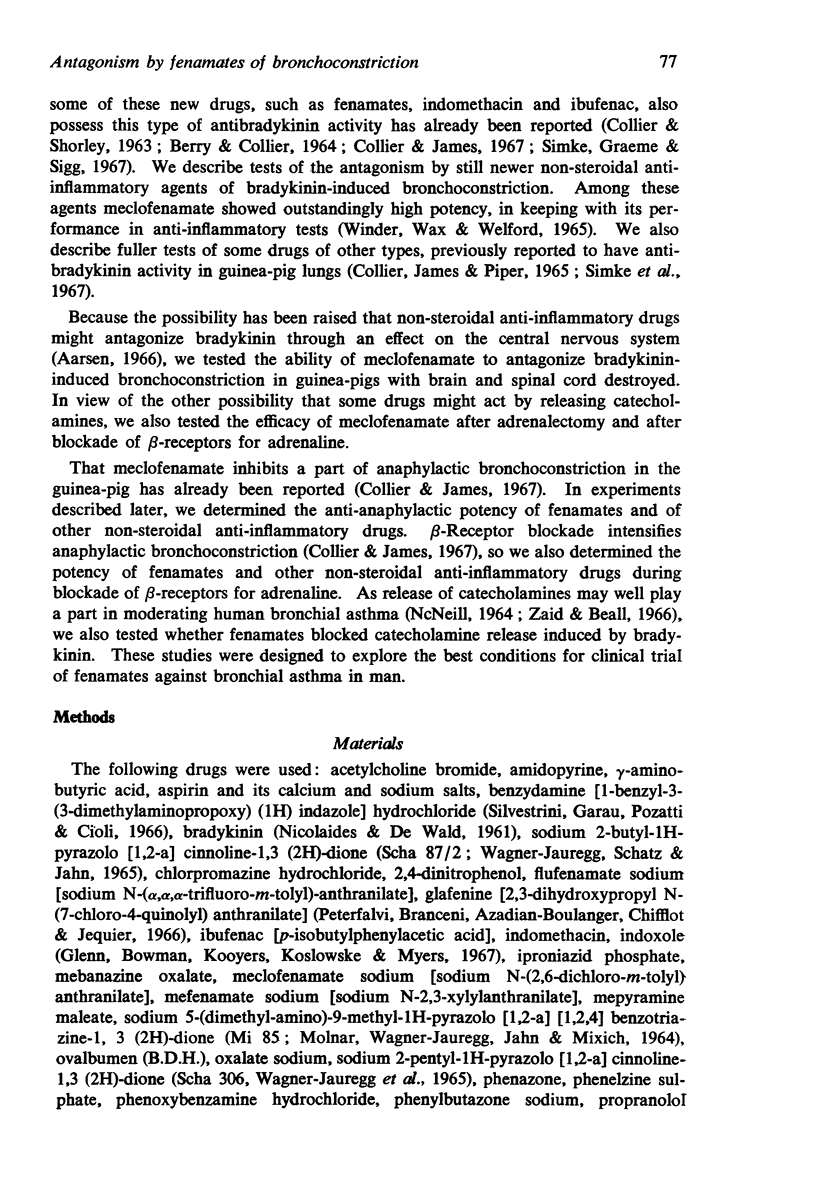
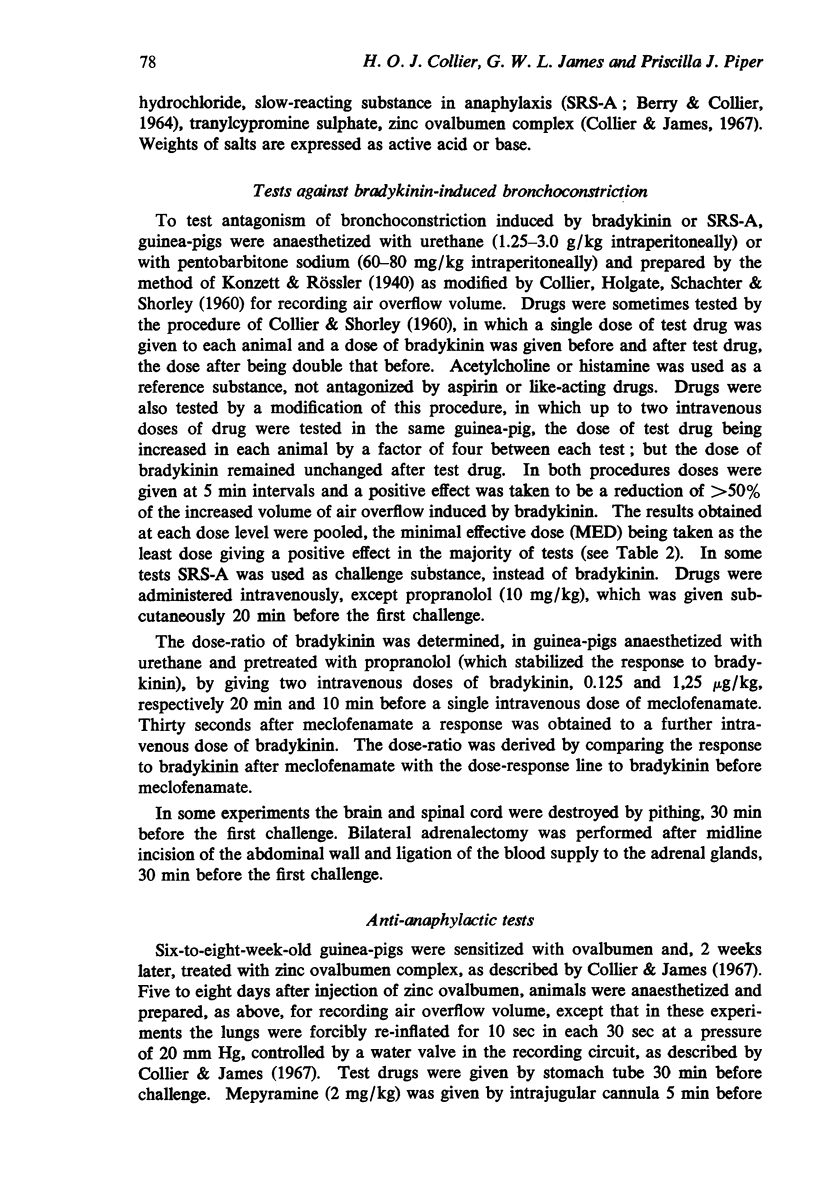
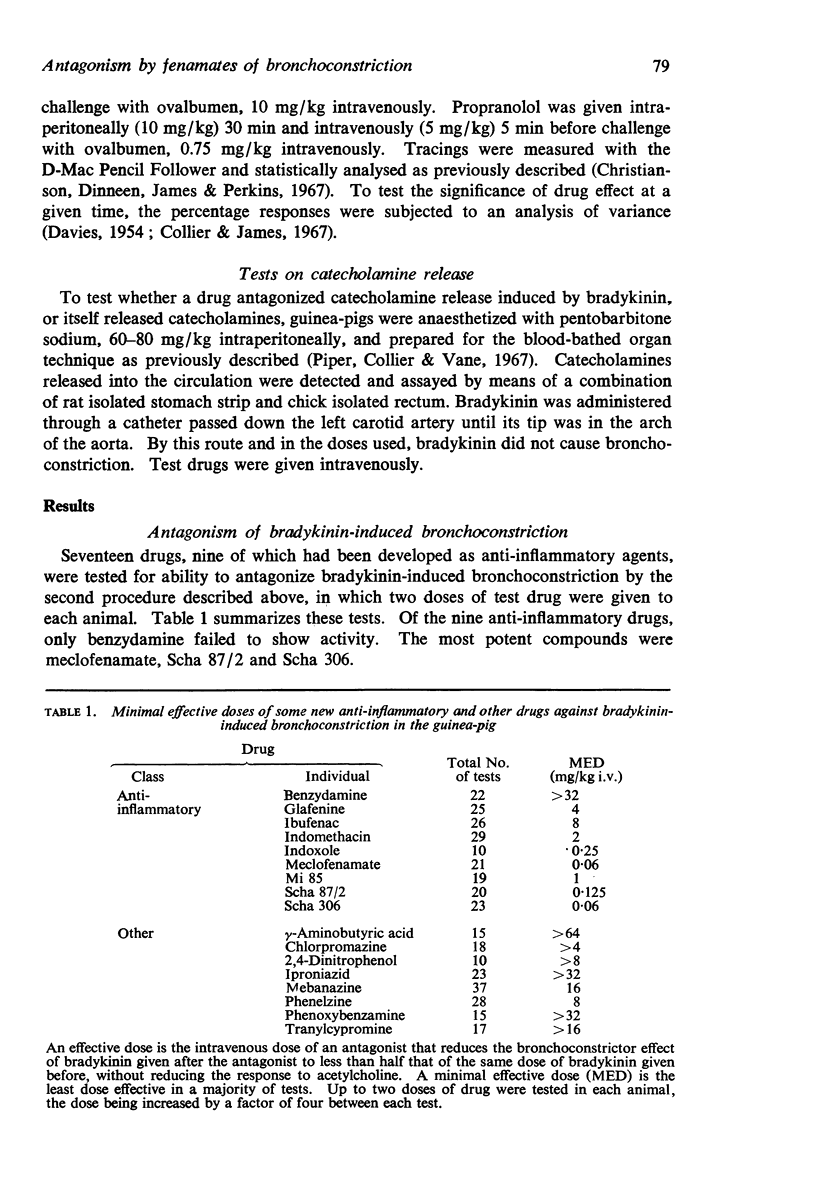

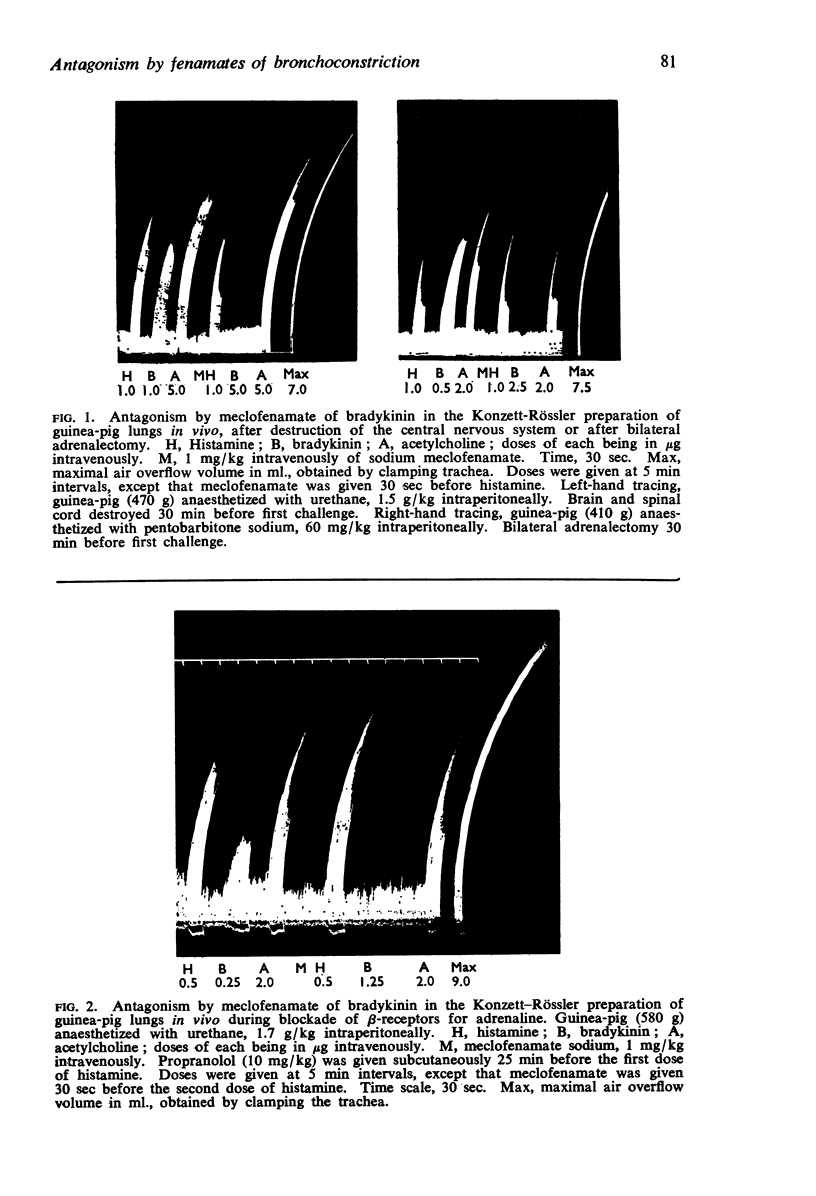
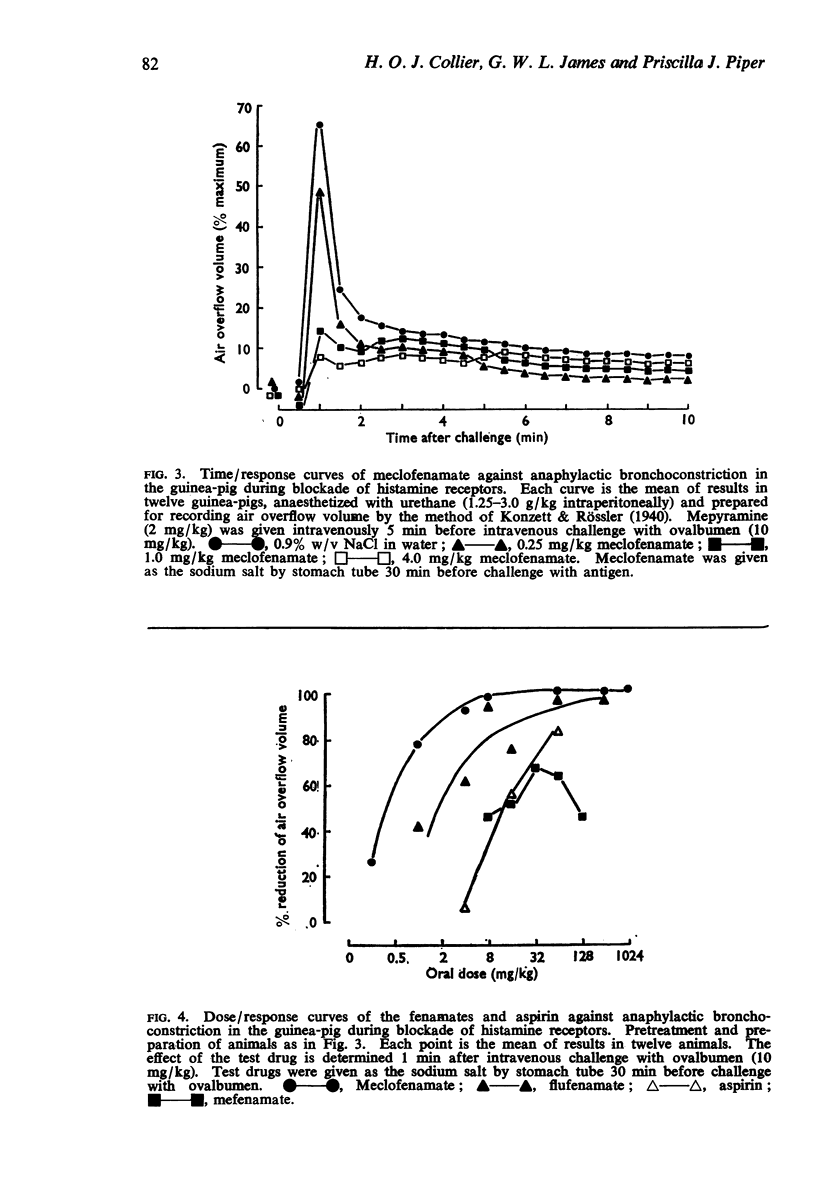
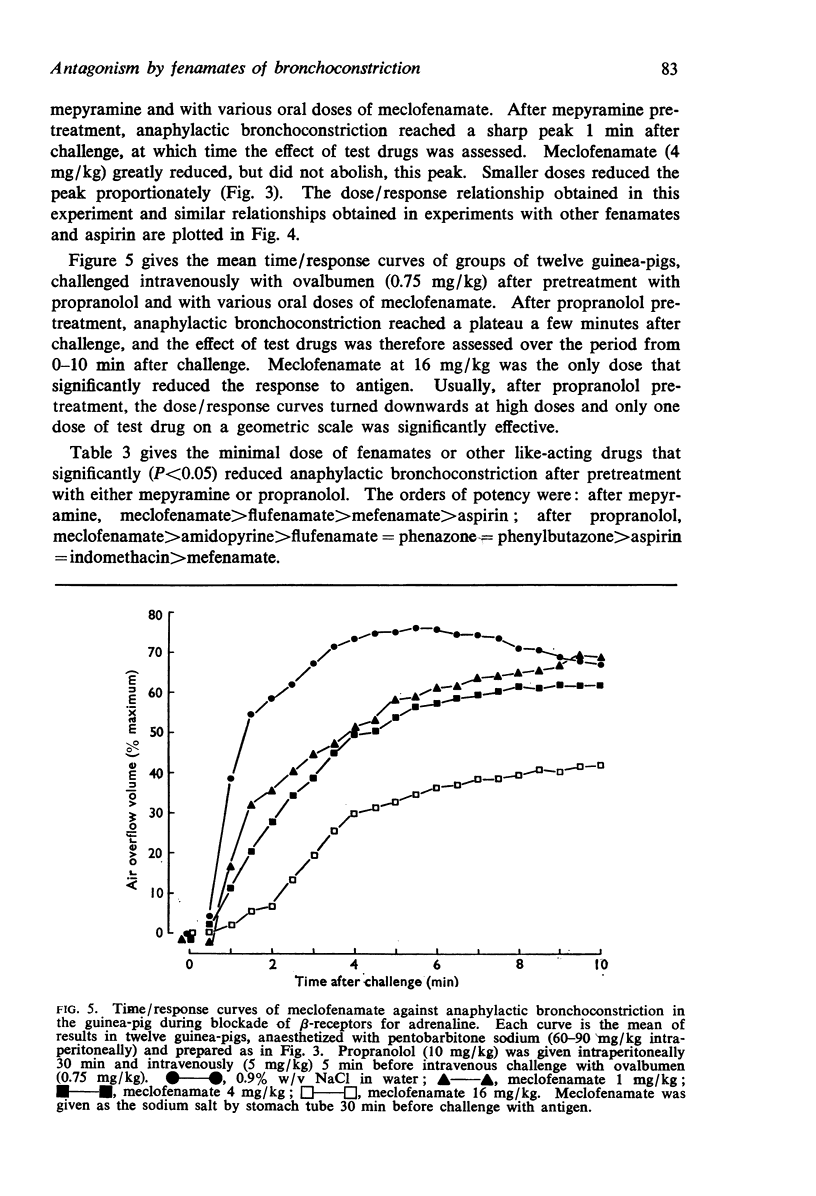
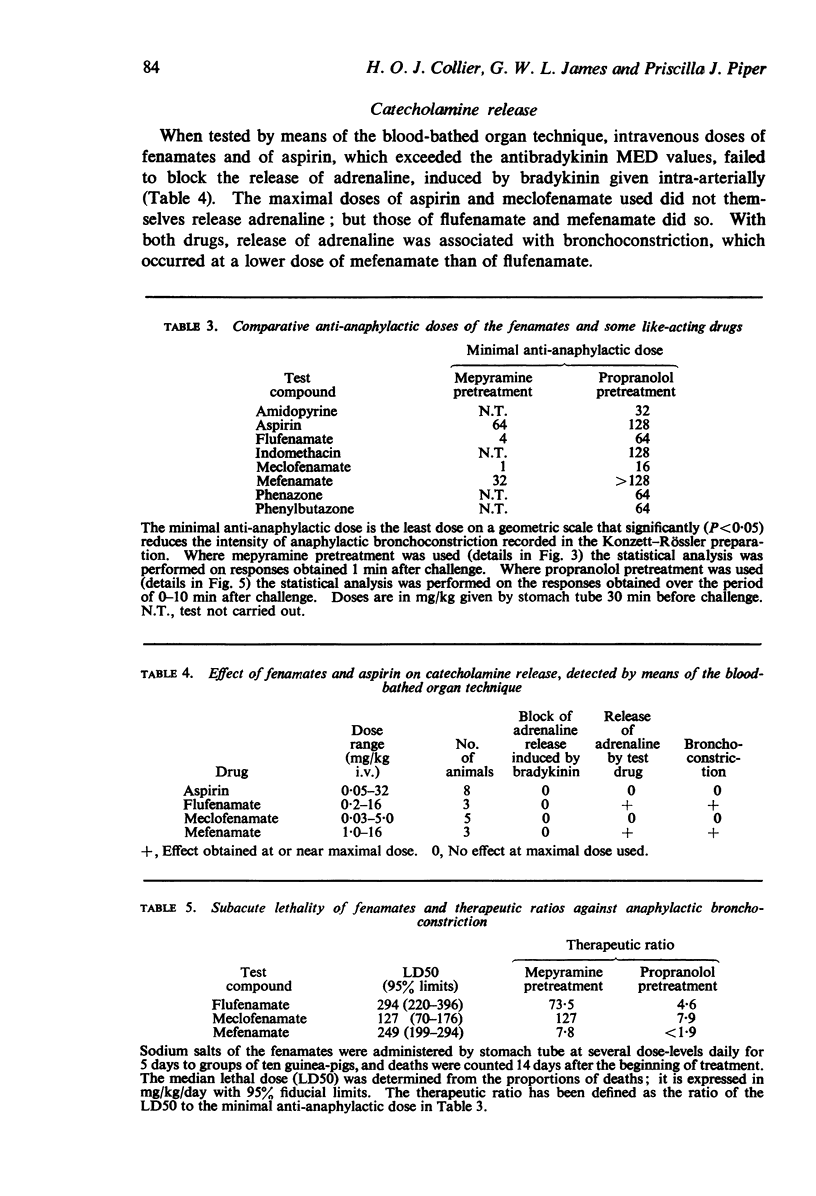
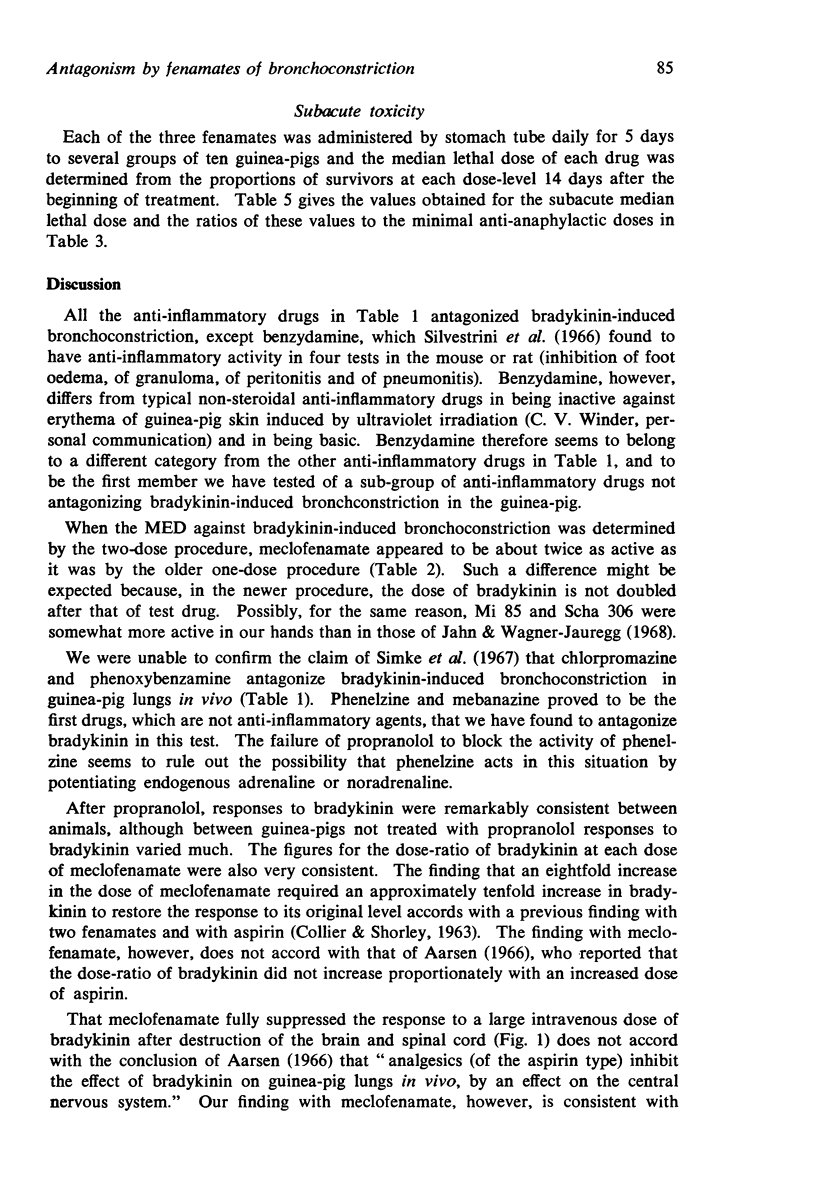
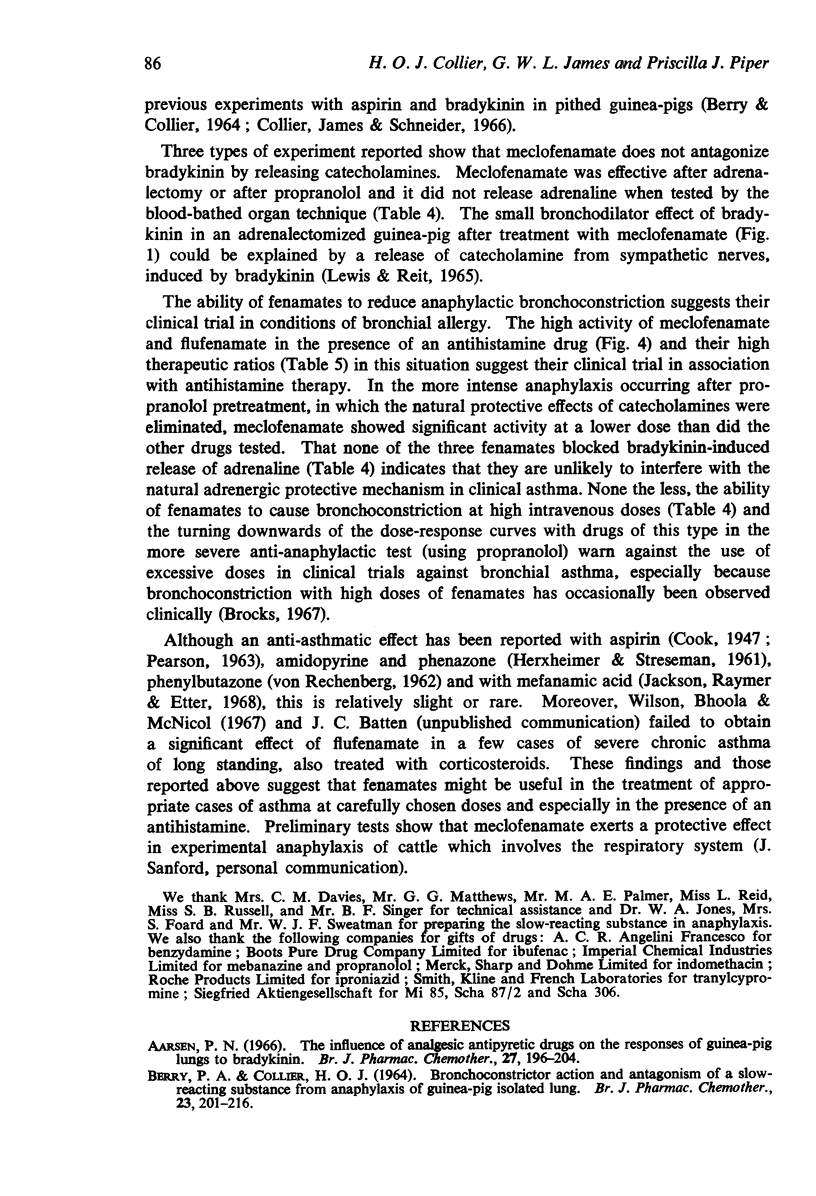
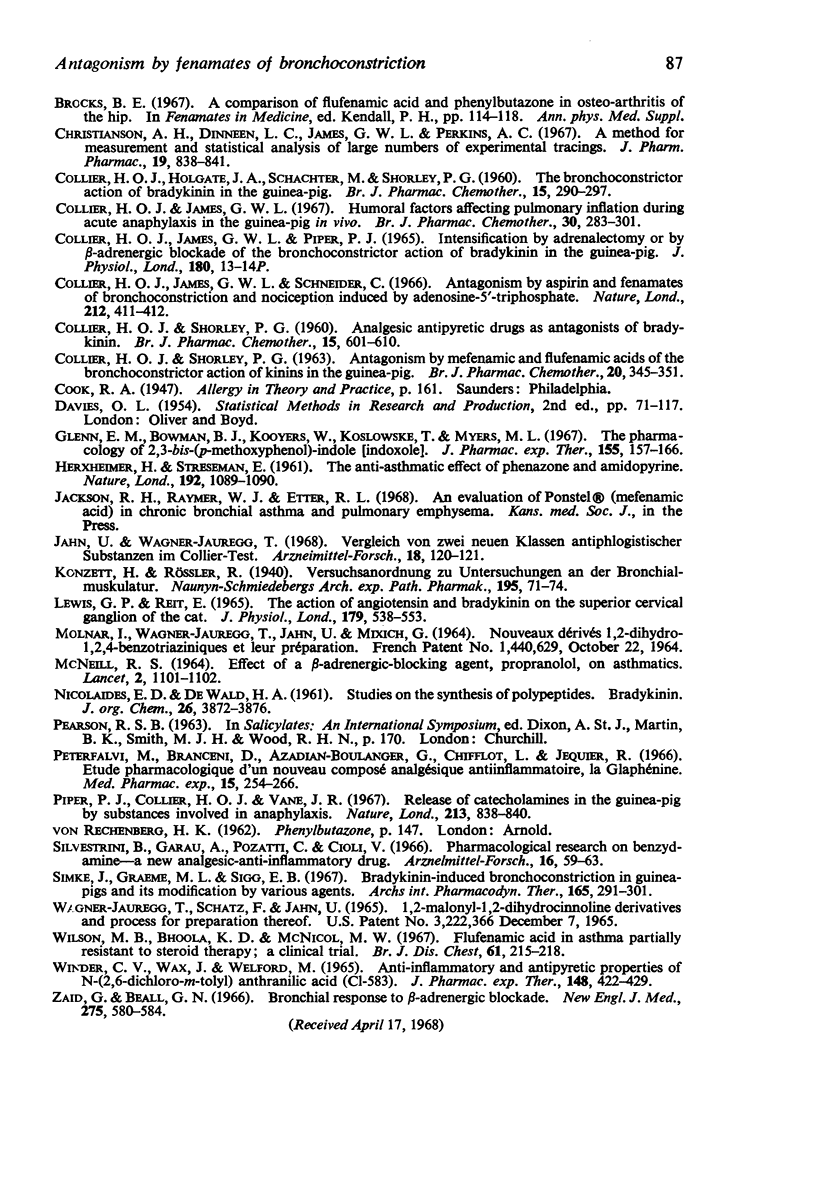
Selected References
These references are in PubMed. This may not be the complete list of references from this article.
- Aarsen P. N. The influence of analgesic antipyretic drugs on the responses of guinea-pig lungs to bradykinin. Br J Pharmacol Chemother. 1966 May;27(1):196–204. [PMC free article] [PubMed] [Google Scholar]
- BERRY P. A., COLLIER H. O. BRONCHOCONSTRICTOR ACTION AND ANTAGONISM OF A SLOW-REACTING SUBSTANCE FROM ANAPHYLAXIS OF GUINEA-PIG ISOLATED LUNG. Br J Pharmacol Chemother. 1964 Aug;23:201–216. doi: 10.1111/j.1476-5381.1964.tb01579.x. [DOI] [PMC free article] [PubMed] [Google Scholar]
- COLLIER H. O., HOLGATE J. A., SCHACHTER M., SHORLEY P. G. The bronchoconstrictor action of bradykinin in the guinea-pig. Br J Pharmacol Chemother. 1960 Jun;15:290–297. doi: 10.1111/j.1476-5381.1960.tb01247.x. [DOI] [PMC free article] [PubMed] [Google Scholar]
- COLLIER H. O., SHORLEY P. G. Analgesic antipyretic drugs as antagonists of bradykinin. Br J Pharmacol Chemother. 1960 Dec;15:601–610. doi: 10.1111/j.1476-5381.1960.tb00288.x. [DOI] [PMC free article] [PubMed] [Google Scholar]
- COLLIER H. O., SHORLEY P. G. Antagonism by mefenamic and flufenamic acids of the bronchoconstrictor action of kinins in the guinea-pig. Br J Pharmacol Chemother. 1963 Apr;20:345–351. doi: 10.1111/j.1476-5381.1963.tb01473.x. [DOI] [PMC free article] [PubMed] [Google Scholar]
- Collier H. O., James G. W. Humoral factors affecting pulmonary inflation during acute anaphylaxis in the guinea-pig in vivo. Br J Pharmacol Chemother. 1967 Jun;30(2):283–301. doi: 10.1111/j.1476-5381.1967.tb02135.x. [DOI] [PMC free article] [PubMed] [Google Scholar]
- Collier H. O., James G. W., Schneider C. Antagonism by aspirin and fenamates of bronchoconstriction and nociception induced by adenosine-5'-triphosphate. Nature. 1966 Oct 22;212(5060):411–412. doi: 10.1038/212411a0. [DOI] [PubMed] [Google Scholar]
- Glenn E. M., Bowman B. J., Kooyers W., Koslowske T., Myers M. L. The pharmacology of 2,3-bis-(p-methoxyphenyl)-indole (indoxole). J Pharmacol Exp Ther. 1967 Jan;155(1):157–166. [PubMed] [Google Scholar]
- HERXHEIMER H., STRESEMANN E. Anti-asthmatic effect of phenazone and amidopyrine. Nature. 1961 Dec 16;192:1089–1090. doi: 10.1038/1921089b0. [DOI] [PubMed] [Google Scholar]
- Lewis G. P., Reit E. The action of angiotensin and bradykinin on the superior cervical ganglion of the cat. J Physiol. 1965 Aug;179(3):538–553. doi: 10.1113/jphysiol.1965.sp007679. [DOI] [PMC free article] [PubMed] [Google Scholar]
- MCNEILL R. S. EFFECT OF A BETA-ADRENERGIC-BLOCKING AGENT, PROPRANOLOL, ON ASTHMATICS. Lancet. 1964 Nov 21;2(7369):1101–1102. doi: 10.1016/s0140-6736(64)92617-0. [DOI] [PubMed] [Google Scholar]
- Piper P. J., Collier H. O. Release of catecholamines in the guinea-pig by substances involved in anaphylaxis. Nature. 1967 Feb 25;213(5078):838–840. doi: 10.1038/213838a0. [DOI] [PubMed] [Google Scholar]
- Silvestrini B., Garau A., Pozzatti C., Cioli V. Pharmacological research on benzydamine-a new analgesic-anti-inflammatory drug. Arzneimittelforschung. 1966 Jan;16(1):59–63. [PubMed] [Google Scholar]
- Simke J., Graeme M. L., Sigg E. B. Bradykinin induced bronchoconstriction in guinea pigs and its modification by various agents. Arch Int Pharmacodyn Ther. 1967 Feb;165(2):291–301. [PubMed] [Google Scholar]
- WINDER C. V., WAX J., WELFORD M. ANTI-INFLAMMATORY AND ANTIPYRETIC PROPERTIES OF N-(2,6-DICHLORO-M-TOLYL)ANTHRANILIC ACID (CI-583). J Pharmacol Exp Ther. 1965 Jun;148:422–429. [PubMed] [Google Scholar]
- Zaid G., Beall G. N. Bronchial response to beta-adrenergic blockade. N Engl J Med. 1966 Sep 15;275(11):580–584. doi: 10.1056/NEJM196609152751103. [DOI] [PubMed] [Google Scholar]


